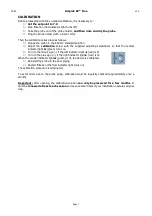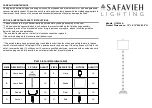
CCEI
Limpido EZ
®
Duo
v1.0
Page 6
START-UP
WARNING : ONLY REGULAR ANALYSES ALLOW ADAPTING THE DEVICE’S PARAMETERS
Scrupulously following the steps below will ensure a trouble-free start-up.
CHECKING THE SALT RATIO
Limpido EZ Duo
is designed to operate with a water conductivity corresponding to a salt content
between 2.5g/l and 5g/l at 25°C.
To check with precision the salt ratio of your pool, we recommend using a conductivity tester. This
very simple to use instrument allows a direct readout of the salt ratio in g/l. In addition, there are
analysis strips to allow efficiently checking your water’s salt content.
When the salt content is inappropriate,
Limpido EZ Duo
stops the production and turns on the
″
overproduction
″
indicator light in case of an excess amount of salt or the
″
underproduction
″
indicator
light in case of a lack of salt. In case one of these indicator lights is lit, first make sure that the cell is
correctly connected to the box and then that it is in good condition and make the necessary
corrections on the pool water.
Water conductivity is not only proportional to the salt content, but also depends on the temperature at
the rate of 2.2% per degree Celsius (°C).
10°C
15°C
20°C
25°C
30°C
35°C
40°C
Min
3.3
3.1
2.8
2.5
2.2
2.0
1.7
Ideal
4.7
4.3
3.9
3.5
3.1
2.7
2.3
Max
6.7
6.1
5.6
5
4.5
3.9
3.4
Salt content in g/l
At 35°C the max salt ratio, therefore, goes from 5g/l to
3.9g/l
.
STABILISER
Chlorine is gaseous at room temperature. Its solid form (pebbles, granules, etc.) is obtained by
association with a molecule of cyanuric acid. This cyanuric acid acts as a stabiliser since it protects the
chlorine from the degradation that the sun’s ultraviolet (UV) radiation subjects it to. On the other
hand, this cyanuric acid is not consumed and inexorably accumulates in pools treated with chlorine
pebbles and finally inhibits the chlorine potential. For public swimming pools, the maximum
concentration of cyanuric acid is set at 80 ppm (or mg/l).
The treatment by electrolysis of the salt prevents such overdosing in cyanuric acid. However, it may
prove useful to add between 25 and 50 ppm (or mg/l) of stabiliser when the pool is very exposed to
sun and the chlorine concentration is insufficient.
In fact, in bright sunlight, 90% of the free chlorine is destroyed in two to three hours in the absence
of cyanuric acid, while this proportion is lowered to 15% with 30ppm of stabiliser (cyanuric acid).
CHECKING TPA AND TH
At the installation time, it is recommended to test or have tested by a specialist the TPA (Total
Phenolphthalein Alkalinity) and/or TH (Titration for Hardness) of the pool water. Both measurements
are generally closely related and are often expressed in degrees Fahrenheit (°F). If TPA and TH are
different, retain an average value of both of these measurements.
However, it is important to point out that a very soft water (TPA/TH <10°F) which offers the
advantage of avoiding scaling is very corrosive, and its pH is very unstable.
Conversely, a very hard water (>35°F) which has a pH difficult to correct is very irritating for the skin
and causes a rapid scaling of the installations. In extreme cases, it is therefore recommended to
correct the TPA and the TH using appropriate chemical products.
Warning : the pH correctors used in pools are very corrosive and can have a harmful effect on health
and on the environment. These chemical products must be handled with precaution and be stored in
adapted premises.






























